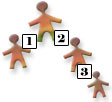| Español | Español | |
Organization and Degree of Familial Relationships in Hispanic Cultures“Parentesco” refers to the links or relationships between members of a family. Understanding how these are organized and measured is important in genealogical research. These links are organized as lines (líneas) and measured in degrees (grados). There are three types of line,
LinesFrom the point of view of a person, named the root (tronco), these lines are labeled as follows (e.g., for purposes of inheritance):
Degrees“Parentesco” is measured in degrees (grados), where each generation counts as one degree. Along the straight lines the “distance” between two members of a family is simply counted as the number of generations between them. For example, a father and his child are one degree apart, and a grand father and his grand child are two degrees apart). In the collateral lines, the distance between two relatives is counted as the sum of the generations that separates each from their common ancestor. This scheme is used, among other things, to determine heirs and the distribution of inheritance. This makes wills and related documents very valuable in genealogical research. In this article, Mariano Nájeraurriola, Esq., explains how this is used in the determination of contested wills and non-assigned inheritance[i]. This systems comes from antiquity[ii] and it has been instituted in law in Puerto Rico[i], Mexico[iii], Argentina[iv], Chile[v] and many other Latin American countries. Below you'll find two tables that should help to illustrate this system. |
||
| Degrees of Separation between Descendents along Blood Lines | ||||||||||
| Common ancestor | Hijo | Nieto | Bisnieto | Tataranieto | Chozno | |||||
|---|---|---|---|---|---|---|---|---|---|---|
| 1G | 2G | 3G | 4G | 5G | ||||||
| Hijo | hermano | tío / sobrino |
tío abuelo / sobrino nieto |
tío bisabuelo / sobrino bisnieto |
tío tatarabuelo / sobrino tataranieto |
|||||
| 1G | 2G | 3G | 4G | 5G | 6G | |||||
| Nieto | tío / sobrino |
primo hermano | tío segundo / sobrino segundo | tío bisabuelo segundo / sobrino bisnieto segundo | tío tatarabuelo segundo / sobrino tataranieto segundo |
|||||
| 2G | 3G | 4G | 5G | 6G | 7G | |||||
| Bisnieto | tío abuelo / sobrino nieto |
tío segundo / sobrino segundo | primo segundo | tío bisabuelo tercero / sobrino bisnieto tercero | tío tatarabuelo tercero / sobrino tataranieto tercero |
|||||
| 3G | 4G | 5G | 6G | 7G | 8G | |||||
| Tataranieto | tío bisabuelo / sobrino bisnieto |
tío bisabuelo segundo / sobrino bisnieto segundo | tío bisabuelo tercero / sobrino bisnieto tercero | primo tercero | tío tatarabuelo cuarto / sobrino tataranieto cuarto |
|||||
| 4G | 5G | 6G | 7G | 8G | 9G | |||||
| Chozno | tío tatarabuelo / sobrino tataranieto |
tío tatarabuelo segundo / sobrino tataranieto segundo |
tío tatarabuelo tercero / sobrino tataranieto tercero |
tío tatarabuelo cuarto / sobrino tataranieto cuarto |
primo cuarto |
|||||
| 5G | 6G | 7G | 8G | 9G | 10G | |||||
| Degrees of Separation between Ascendants/Descendents | ||||||||
| Tronco | Padre | Abuelo | Bisabuelo | Tatarabuelo | ||||
|---|---|---|---|---|---|---|---|---|
| 1G | 2G | 3G | 4G | |||||
| Hijo | abuelo / nieto | bisabuelo / bisnieto |
tatarabuelo / tataranieto |
trastatarabuelo / chozno |
||||
| 1G | 2G | 3G | 4G | 5G | ||||
| Nieto | bisabuelo / bisnieto |
tatarabuelo / tataranieto |
trastatarabuelo / chozno |
|||||
| 2G | 3G | 4G | 5G | 6G | ||||
| Bisnieto | tatarabuelo / tataranieto |
trastatarabuelo / chozno |
||||||
| 3G | 4G | 5G | 6G | 7G | ||||
| Tataranieto | trastatarabuelo / chozno |
|||||||
| 4G | 5G | 6G | 7G | 8G | ||||
For more material on this subject, see the following:
|
 For example, a brother and a sister are two degrees apart, one from the brother to their parents and another degree from the parents to the sister. Between an uncle and his nephew there are three degrees of separation: one degree up between the uncle and his parents and two more degrees between them and his nephew.
For example, a brother and a sister are two degrees apart, one from the brother to their parents and another degree from the parents to the sister. Between an uncle and his nephew there are three degrees of separation: one degree up between the uncle and his parents and two more degrees between them and his nephew.